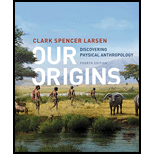
Concept explainers
Introduction: In taxonomical order, primate members belong to animal groups. They are different from mammals and found all over the world. They have a unique combination of traits. The dental pattern of primates are different from others. They possess forward-facing eyes and grasping hands and feet.
Answer to Problem 1SQ
Correct answer: c.
Explanation of Solution
Reason for the correct answer:
According to the angiosperm radiation hypothesis, the availability of fruits and flowers are acquired by primates with the help of visual acuity and grasping hands. This is because of the spread of angiosperms in the early Cenozoic. Thus, this hypothesis specifically linked with the evolution of primates.
Option c. is given as “angiosperm radiation hypothesis”.
Hence, the correct answer is option c.
Reasons for incorrect answers:
Option a. is given as “arboreal hypothesis”.
The arboreal hypothesis explains the evolution of primates based on their unique adaption to living on trees. Therefore, option a is incorrect.
Option b. is given as “visual predation hypothesis”.
This hypothesis reveals the characters of primates are an adaptation to prey on small insects and animals. Therefore, option b. is incorrect.
Option d. is given as “gymnosperm radiation hypothesis”.
There is no gymnosperm radiation hypothesis that exists for the evolution of primates. Therefore, option d. is incorrect.
Hence, options a., b., and d. are incorrect.
Thus, the angiosperm radiation hypothesis specifically links the evolution of primates.
Want to see more full solutions like this?
Chapter 9 Solutions
Our Origins: Discovering Physical Anthropology (Fourth Edition)
- Explain how the hormones of the glands listed below travel around the body to target organs and tissues : Pituitary gland Hypothalamus Thyroid Parathyroid Adrenal Pineal Pancreas(islets of langerhans) Gonads (testes and ovaries) Placentaarrow_forwardWhat are the functions of the hormones produced in the glands listed below: Pituitary gland Hypothalamus Thyroid Parathyroid Adrenal Pineal Pancreas(islets of langerhans) Gonads (testes and ovaries) Placentaarrow_forwardDescribe the hormones produced in the glands listed below: Pituitary gland Hypothalamus Thyroid Parathyroid Adrenal Pineal Pancreas(islets of langerhans) Gonads (testes and ovaries) Placentaarrow_forward
- Please help me calculate drug dosage from the following information: Patient weight: 35 pounds, so 15.9 kilograms (got this by dividing 35 pounds by 2.2 kilograms) Drug dose: 0.05mg/kg Drug concentration: 2mg/mLarrow_forwardA 25-year-old woman presents to the emergency department with a 2-day history of fever, chills, severe headache, and confusion. She recently returned from a trip to sub-Saharan Africa, where she did not take malaria prophylaxis. On examination, she is febrile (39.8°C/103.6°F) and hypotensive. Laboratory studies reveal hemoglobin of 8.0 g/dL, platelet count of 50,000/μL, and evidence of hemoglobinuria. A peripheral blood smear shows ring forms and banana-shaped gametocytes. Which of the following Plasmodium species is most likely responsible for her severe symptoms? A. Plasmodium vivax B. Plasmodium ovale C. Plasmodium malariae D. Plasmodium falciparumarrow_forwardStandard Concentration (caffeine) mg/L Absorbance Reading 10 0.322 20 0.697 40 1.535 60 2.520 80 3.100arrow_forward
- please draw in the answers, thank youarrow_forwarda. On this first grid, assume that the DNA and RNA templates are read left to right. DNA DNA mRNA codon tRNA anticodon polypeptide _strand strand C с A T G A U G C A TRP b. Now do this AGAIN assuming that the DNA and RNA templates are read right to left. DNA DNA strand strand C mRNA codon tRNA anticodon polypeptide 0 A T G A U G с A TRParrow_forwardplease answer all question below with the following answer choice, thank you!arrow_forward

 Concepts of BiologyBiologyISBN:9781938168116Author:Samantha Fowler, Rebecca Roush, James WisePublisher:OpenStax College
Concepts of BiologyBiologyISBN:9781938168116Author:Samantha Fowler, Rebecca Roush, James WisePublisher:OpenStax College- Understanding Health Insurance: A Guide to Billin...Health & NutritionISBN:9781337679480Author:GREENPublisher:CengageCase Studies In Health Information ManagementBiologyISBN:9781337676908Author:SCHNERINGPublisher:CengageEssentials Health Info Management Principles/Prac...Health & NutritionISBN:9780357191651Author:BowiePublisher:Cengage





